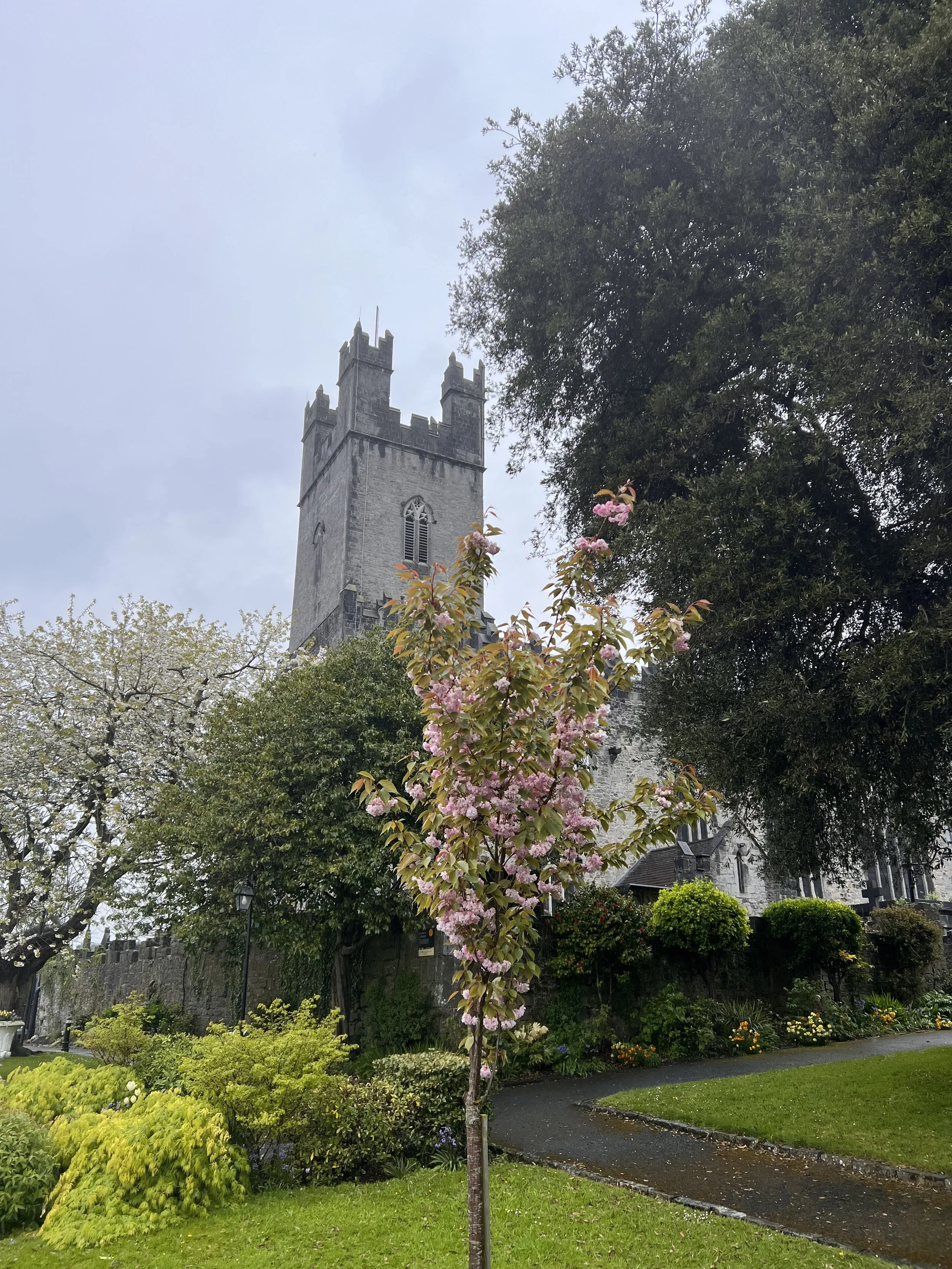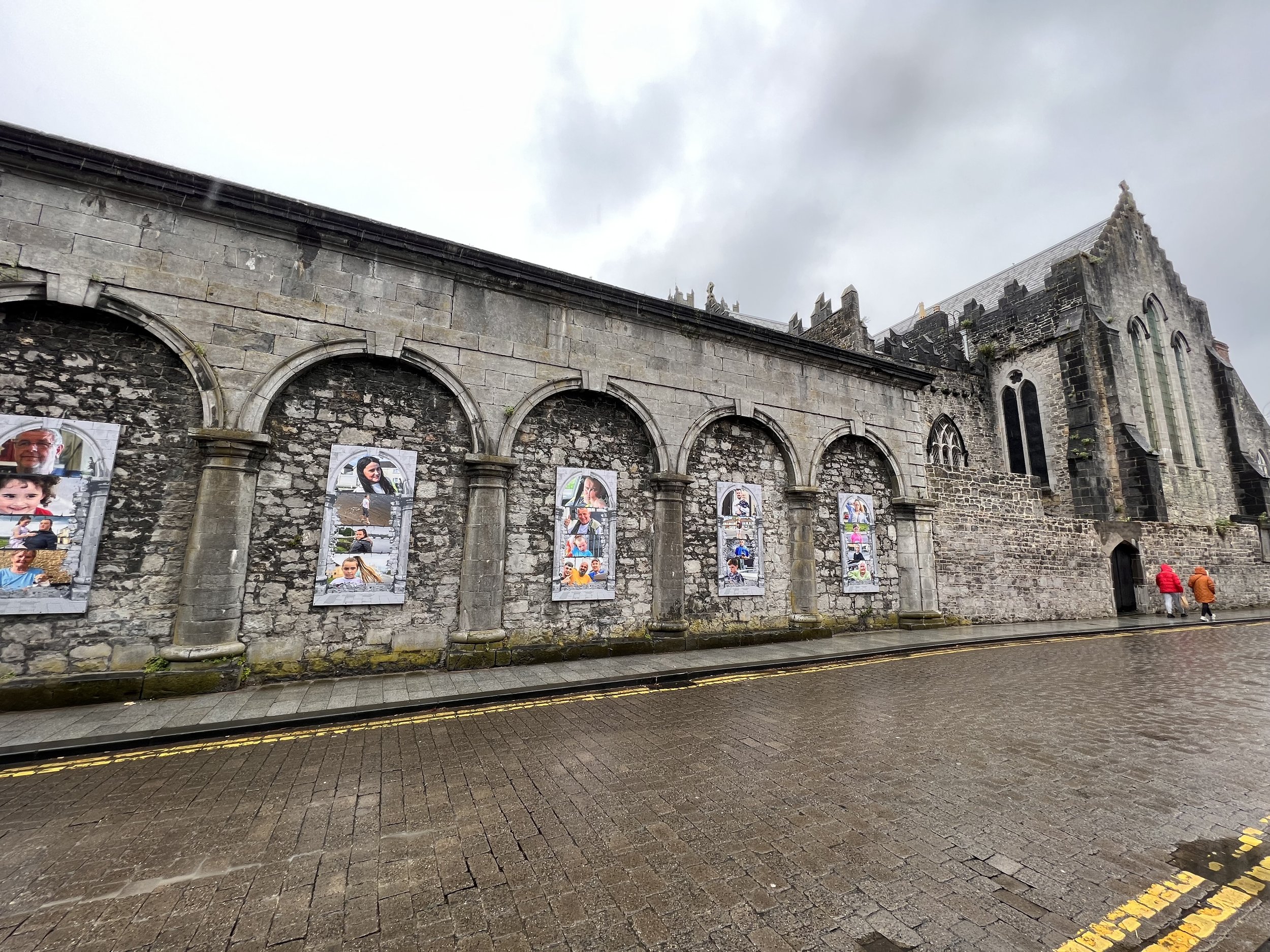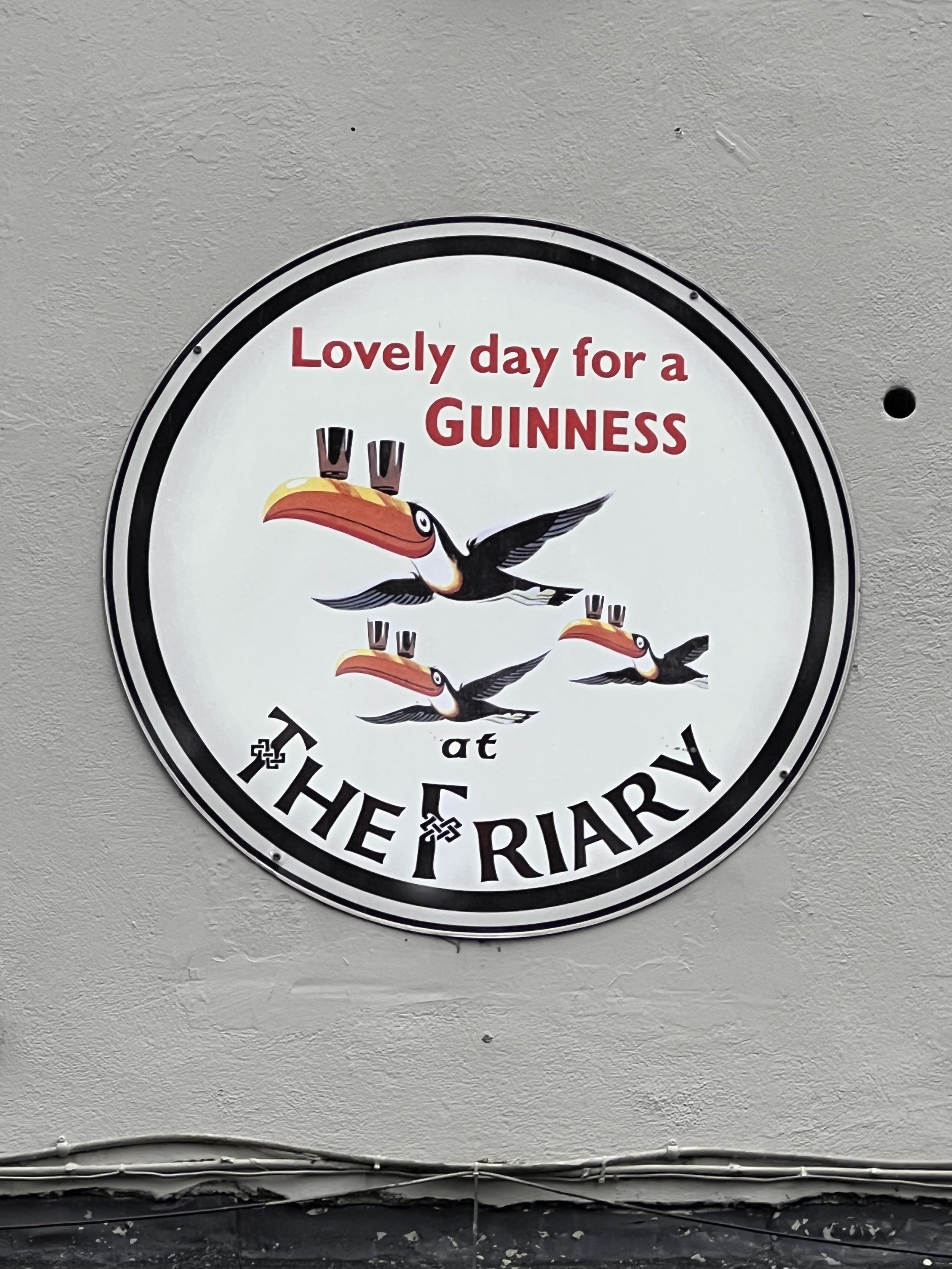Limerick
“There once was a man and his wife
Who wanted to start a new life
So they traveled abroad
By the new sights they were awed
And they had never both felt more alive.
And then they came up with a plan
To visit more pretty green land
And so they sailed over
To the land filled with clover
And thought, Well isn’t this grand?”
St Mary’s Cathedral, Limerick
A limerick is a form of verse, usually humorous and frequently rude, in five-line, with a strict rhyme scheme of AABBA, in which the first, second and fifth line rhyme, while the third and fourth lines are shorter and share a different rhyme.
The origin of the name limerick for this type of poem is debated. The name is generally taken to be a reference to the City or County of Limerick in Ireland, sometimes particularly to the Maigue Poets, and may derive from an earlier form of nonsense verse parlor game that traditionally included a refrain that included "Will [or won't] you come (up) to Limerick?"
Rock of Dunamase
About an hour west of Dublin are the ruins of Dunamase Castle or the Rock of Dunamase. The castle was blown up by Cromwell’s Parliamentarian forces in order to prevent the Irish using it against the English.
How the castle looked when it was completed in the late 12th century.
The Castle today and largely how it appeared as “Ballycarbery Castle” in the movie Leap Year, although the movie introduced a lot of CGI to create the effect they wanted.
The castle’s Barbican Gate (a fortified gateway in an outer defense perimeter), should look familiar from the movie. The large tower at the top only exists in post production.
Anna and Declan approach the Barbican Gate in Leap Year.
Looking into what was once the castle’s Great Hall.
Looking out a doorway from the Great Hall (the mini rainbow 🌈 on the wall is apropos).
The castle ruins, as Anna and Declan saw them, included a tower and the remains of a large window that were never part of the original castle.
The Rock may actually sit in County Laois (not County Tipperary), it may not be near a train station, and it may not sit atop of a large hill…
And the view from the castle’s non-existent tower may not be as dramatic as depicted in the film—but that’s why we call it movie magic! As people we are deeply drawn to stories and movies allow us to imagine stories in powerful ways. I say keep the magic coming!
Moneygall
So there we were, barreling down M7 when we see a road sign that says Barak Obama Plaza. I had to pinch myself to make sure I was still in Ireland and hadn’t imagined it, so we took the exit (the “slip road”) to have a look.
Sure enough, an entire plaza dedicated to our 44th President, his Irish heritage, and his visit to the town on May 23, 2011.
Upstairs is a large conference center and museum dedicated not only to Obama’s connection with Moneygall, but also the three other presidents with Irish heritage: Kennedy, Reagan, and Clinton.
In 2008, a researcher learned Barack was the great-great-great grandson of a Moneygall resident. Three years later, President Obama made a pilgrimage to the village of his ancestor.
President Barack Obama and the First Lady Michelle touched down on Air Force One at Dublin Airport. The Obamas then travelled on Marine One to Moneygall to visit his ancestral home, where they were greeted by local-man Henry Healy, President Obama's distant cousin.
They then spent time meeting and greeting some of the hundreds of onlookers before visiting the local “siopa beag” (Irish for shop) and having a pint in Ollie Hayes’s pub.
The Gathering Bowl—It is now a well-established tradition that every St Patrick's Day a crystal bowl filled with Irish shamrock is presented to the President of the United States. This is a replica of the Gathering Bowl that was presented to President Barack Obama by An Taoiseach Enda Kenny on March 17, 2013.
As with the original, it was designed and engraved by Sean Egan, master crystal-engraver, formerly of Waterford Crystal. The engravings depict a ship departing for America during the Great Hunger and symbols representative of Ireland and its people.
The People's Museum of Limerick
Francis McCourt was an Irish-American teacher and writer. He won a Pulitzer Prize for his book Angela's Ashes, a tragicomic memoir of the misery and squalor of his childhood in Limerick.
We decided to visit his museum before making our way to our next place. It turned out the Frank McCourt Museum had been closed and the contents moved to The People’s Museum of Limerick.
The tour was a disappointment both because we were tired and hungry and the guide longwinded, but also because there was a shocking lack of anything related to McCourt or his writings. The collection is “eclectic” at best.
The bike from the 1999 movie by the same name. I finally read the book in February and really enjoyed it!
Earlson Farmhouse
You can check out their webpage here and take our video tour here: https://www.youtube.com/watch?v=9_eLiHTX0LI
The Clare Glens
On Friday (Apr 21) we went for a 2.5 mile walk along this beautiful forested riverside trail.
Driving in Ireland
So far, the roads in Ireland are a huge improvement over the UK. The roadways are generally wider, in better condition, and the markings are maintained. In the rain, the markings on a typical road in England will virtually disappear!
One oddity in Ireland though: on some two-lane, two-way roads, the lanes are exceptionally wide. I thought this was wonderful until I realized it was because on-coming traffic will cross over the centerline to pass slower traffic—and they will do this regardless of whether or not there is opposing traffic. Despite the lane width, you must stay to the left side of your lane to avoid a possible head-on collision.
The vehicle ahead of us knows he is traveling slower than the flow of traffic, so he cheats left while he drives, fully expecting you to pass on the right. It’s an interesting set up.
Milk Market
The Limerick Market Trustees were incorporated in 1852 for the purpose of providing, managing, regulating, and governing markets and market places in the Borough of Limerick. The Limerick Milk Market is one of its flagship markets and has become quite famous.
Saturday is the biggest day for the popular Market, so we worked our schedule around visiting on Saturday (Apr 22). Despite the general lack of vegan options in Ireland, there were at least four vegan vendors at the small market—not bad. (We anticipated eating might be more challenging in Ireland and that has proven to be the case. As a small example, most coffee shops don’t offer oat milk.) We bought fresh lettuce, some really tasty mixed salads, a sourdough loaf, and a dessert. A lot of wonderful, fresh food was on offer, and it’s always wonderful to listen to the Irish speaking.
Afterward, we split up. Amanda did some thrift store browsing and I walked around to see some of the City’s major sights.
St Mary’s Cathedral
The Exchange Wall—The exchange was built in 1673. This impressive façade of hewn stone with its seven Tuscan columns linked by a handsome balustrade is all that remains of the original building. The structure was rebuilt in 1702 and 1778. It fell into disuse when the new town hall was constructed across the bridge in Rutland Street in 1846. The east wall of St Mary’s Cathedral is in the background.
St Mary’s Catholic Church, not to be confused with nearby St Mary’s Cathedral above.
Never mind church-and-state, what about church-and-beer? 😂
Michael Hogan, The Bard of Thomond (1826-1899), who was wounded by a sniper's bullet during the Irish Revolution from British rule during 1916-1922, while in the military service to his country in the Irish Republican Army.
The Thomond Bridge over the River Shannon.
Clancy Strand along the west side of the River Shannon. King John’s Castle is on the east side (and St Mary’s Cathedral jutting about the skyline).
Treaty Stone—Monument with a stone said to be used in the signing of the 1691 Treaty of Limerick.
Jack Monday’s Coffee House, also on the east side of the River Shannon at the Thomond Bridge. Surprise, surprise—they had oat milk! 👍
Here is the story inside Jack Monday’s Coffee House explaining their name:
In the dead of night, fifty Free State soldiers marched up William Straat from Murphy's headquarter's in the Police Barracks to take control of the prison. They expected an attack from the IRA garrison in the Ordnance barracks, but it never came. Upon entering the prison itself they were greeted by even bigger surprise. As they went from cell to cell reviewing and interrogating the prisoners, they came across a West African called Jack Monday, this came as quiet a shock to the Free State soldiers who had never laid eyes on a black man before with the exception of statues of St Martin.
Jack had arrived in Limerick working as a fitter on a ship in December 1921. As his boat was leaving the port it followed maritime custom by hoisting the flag of the country from which it was departing, but instead of flying the British flag it flew the Irish tricolour. The ship was immediately boarded by a party of Black & Tans and a fight ensued during which Jack stabbed two of them. He had been imprisoned in Limerick Prison ever since without being sentenced.
At the suggestion of his liberators, who could find no fault against him, he joined the Transit Corps of the Free State army some time later and was stationed at Gormanstown camp until 1928. He was even supposed to have gone so far as to have changed his name to the Irish at some stage, becoming Sean De Luain.
JJ Bowles, supposedly Limerick’s oldest pub. It wasn’t open yet, so sadly no Guinness was to be had.
Shooting the River Shannon rapids? I believe there is some sort of design which causes the turbulence in this spot.
Sarsfield Swivel Bridge. Think it rains a lot here?
Memorial dedicated to the memory of those who died in the struggle for Irish freedom and Easter Rising of 1916, both those killed in action and the leaders executed in its aftermath.
The front of the Memorial contains a plaque inscribed with the 1916 Proclamation. Also inscribed on the Memorial are the names of the 16 men executed during May 1916 and on the side panels are the names of others killed in action during the Rising.
The bronze figures are Tom Clarke, Freeman of Limerick, pointing to the Proclamation and on the pedestal are Edward Daly and Con Colbert depicted freeing Mother Eire, represented by a young maiden, from the shackles of oppression.
In honor of The Boys in the Boat book, here is a rowing club in Limerick (see the small plaque on the brick building).
The Shannon River Weir.
Sylvester O'Halloran footbridge, leading to the old Potato Market.
From the Matthew Bridge looking over the River Abbey, the eastern spur of the River Shannon that flows around and creates King’s Island.
Limerick was once a walled city and fragments of the wall can be found throughout the city.





















































